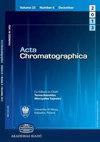高效液相色谱法分析东莨菪碱及其有关物质
IF 1.7
4区 化学
Q3 CHEMISTRY, ANALYTICAL
引用次数: 0
摘要
在硅基高效液相色谱固定相上研究了东莨菪碱(海莨菪碱)及其相关化合物(去海莨菪碱、阿托品、homatropine和noratropine)的保留行为。用Soczewiński-Wachtmeister方程解释了所研究的tropane生物碱的保留率。保留参数(log k)与亲脂性(log P)之间的高度相关(R = 0.9923)证实了疏水相互作用对上述化合物保留行为的显著影响。结果发现,通过增加乙腈馏分,极性较强的环氧化物衍生物(东莨菪碱、去氧莨菪碱)的保留率降低,亲脂性较强的衍生物(阿托品、去氧阿托品、homatropine)的保留率增加。以乙腈和40 mM乙酸铵/0.05% TEA, pH 6.5为流动相,采用简单的分离方法可获得最佳分离效果;50:50 v / v。采用一定条件测定盐酸东莨菪碱滴眼液(氢溴东莨菪碱0.25%)的含量。结果表明,该方法选择性好、灵敏度高、精密度高、准确度高、鲁棒性好,可用于东莨菪碱相关化合物的进一步定性分析。本文章由计算机程序翻译,如有差异,请以英文原文为准。
Analysis of scopolamine and its related substances by means of high-performance liquid chromatography
The retention behaviour of scopolamine (hyoscine) and its related compounds (norhyoscine, atropine, homatropine, and noratropine) was investigated on the silica-based HPLC stationary phase. The retention of investigated tropane alkaloids was interpreted by using the Soczewiński-Wachtmeister equation. A high correlation between the retention parameter (log k) and lipophilicity (log P) (R = 0.9923) confirms the significant influence of hydrophobic interactions on the retention behaviour of the aforementioned compounds. It was found that by increasing the acetonitrile fraction, a decrease in retention of the more polar epoxide derivatives (scopolamine, norhyoscine) and an increase in retention of the more lipophilic derivatives (atropine, noratropine, homatropine) is obtained. The best separation of the tropane alkaloids was achieved by a simple procedure that involved a mobile phase composed of acetonitrile and 40 mM ammonium acetate/0.05% TEA, pH 6.5; 50:50 v/v. Selected conditions were assumed for the determination of scopolamine hydrochloride in the eye drops (Scopolamini hydrobromidum 0.25%). The method was validated and it was found as selective, sensitive, precise, accurate, and robust for the further qualitative analysis of the scopolamine-related compounds.
求助全文
通过发布文献求助,成功后即可免费获取论文全文。
去求助
来源期刊

Acta Chromatographica
化学-分析化学
CiteScore
4.00
自引率
0.00%
发文量
55
审稿时长
2.3 months
期刊介绍:
Acta Chromatographica
Open Access
Acta Chromatographica publishes peer-reviewed scientific articles on every field of chromatography, including theory of chromatography; progress in synthesis and characterization of new stationary phases; chromatography of organic, inorganic and complex compounds; enantioseparation and chromatography of chiral compounds; applications of chromatography in biology, pharmacy, medicine, and food analysis; environmental applications of chromatography; analytical and physico-chemical aspects of sample preparation for chromatography; hyphenated and combined techniques; chemometrics and its applications in separation science.
 求助内容:
求助内容: 应助结果提醒方式:
应助结果提醒方式:


